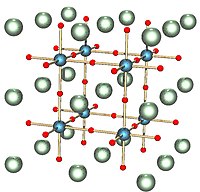
Photo from wikipedia
Lead halide perovskite nanocrystals are highly attractive for next‐generation optoelectronics because they are easy to synthesize and offer great compositional and morphological tunability. However, the replacement of lead by tin… Click to show full abstract
Lead halide perovskite nanocrystals are highly attractive for next‐generation optoelectronics because they are easy to synthesize and offer great compositional and morphological tunability. However, the replacement of lead by tin for sustainability reasons is hampered by the unstable nature of Sn2+ oxidation state and by an insufficient understanding of the chemical processes involved in the synthesis. Here, an optimized synthetic route is demonstrated to obtain stable, tunable, and monodisperse CsSnI3 nanocrystals, exhibiting well‐defined excitonic peaks. Similar to lead halide perovskites, these nanocrystals are prepared by combining a precursor mixture of SnI2, oleylamine, and oleic acid, with a Cs‐oleate precursor. Among the products, nanocrystals with 10 nm lateral size in the γ‐orthorhombic phase prove to be the most stable. To achieve such stability, an excess of precursor SnI2 as well as substoichiometric Sn:ligand ratios are key. Structural, compositional, and optical investigations complemented by first‐principle density functional theory calculations confirm that nanocrystal nucleation and growth follow the formation of (R‐NH3+)2SnI4 nanosheets, with R = C18H35. Under specific synthetic conditions, stable mixtures of 3D nanocrystals CsSnI3 and 2D nanosheets (Ruddlesden–Popper (R‐NH3+)2Csn−1SnnI3n+1 with n > 1) are obtained. These results set a path to exploiting the high potential of Sn halide perovskite nanocrystals for opto‐electronic applications.
Journal Title: Advanced Materials
Year Published: 2022
Link to full text (if available)
Share on Social Media: Sign Up to like & get
recommendations!